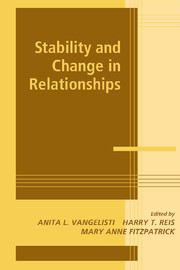Book contents
- Frontmatter
- Contents
- Contributors
- Preface
- PART ONE ACTORS: THE SCAFFOLDING OF STABILITY AND CHANGE
- PART TWO BEHAVIORS: THE PROCESSES OF STABILITY AND CHANGE
- PART THREE CONTEXTS: SOCIAL ENVIRONMENTS FOR STABILITY AND CHANGE
- 11 Social Networks and Change in Personal Relationships
- 12 Creating a Context for Change: Integrative Couple Therapy
- 13 Passionate Love and Sexual Desire: Cultural and Historical Perspectives
- 14 Rules for Responsive Robots: Using Human Interactions to Build Virtual Interactions
- Author Index
- Subject Index
11 - Social Networks and Change in Personal Relationships
Published online by Cambridge University Press: 21 October 2009
- Frontmatter
- Contents
- Contributors
- Preface
- PART ONE ACTORS: THE SCAFFOLDING OF STABILITY AND CHANGE
- PART TWO BEHAVIORS: THE PROCESSES OF STABILITY AND CHANGE
- PART THREE CONTEXTS: SOCIAL ENVIRONMENTS FOR STABILITY AND CHANGE
- 11 Social Networks and Change in Personal Relationships
- 12 Creating a Context for Change: Integrative Couple Therapy
- 13 Passionate Love and Sexual Desire: Cultural and Historical Perspectives
- 14 Rules for Responsive Robots: Using Human Interactions to Build Virtual Interactions
- Author Index
- Subject Index
Summary
Intimate relationships begin, develop, are maintained, change, and dissolve within a larger environment. Although personal characteristics of the pair members and properties that emerge from their interaction (e.g., love) affect the temporal course and outcome of a relationship, the larger environment also is important, and, in fact, can influence the properties that emerge in the pair's interaction. The environment includes both physical forces (e.g., proximity, physical setting) and social networks. The focus of this chapter is on social networks of family and friends and their influences on change and stability in intimate relationships.
Social scientists interested in relationship development, satisfaction, commitment, stability, and other relationship phenomena have generally neglected social environmental explanations, as noted many years ago (e.g., Ridley & Avery, 1979) and also more recently (Berscheid, 1999; Berscheid & Reis, 1998). However, theoretical and empirical contributions on the influence of social networks on intimate relationships have been growing. In the first section of this chapter, we provide a synthesis of previous theoretical statements linking social networks with personal relationships and highlight what we believe to be the network processes and attributes most likely to influence relationships. Next we discuss how these network processes and attributes are related to the formation, development, and stability versus dissolution of premarital relationships. The third section provides a review of the influence of social networks on marriage and other committed relationships.
- Type
- Chapter
- Information
- Stability and Change in Relationships , pp. 257 - 284Publisher: Cambridge University PressPrint publication year: 2002
- 52
- Cited by



